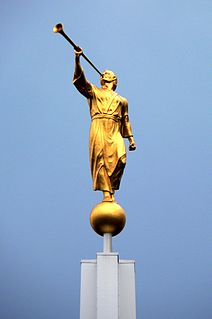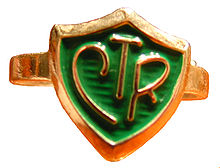
Mormonism is the religious tradition and theology of the Latter Day Saint movement of Restorationist Christianity started by Joseph Smith in Western New York in the 1820s and 1830s. As a label, Mormonism has been applied to various aspects of the Latter Day Saint movement, although there has been a recent push from The Church of Jesus Christ of Latter-day Saints to distance themselves from this label. A historian, Sydney E. Ahlstrom, wrote in 1982, "One cannot even be sure, whether [Mormonism] is a sect, a mystery cult, a new religion, a church, a people, a nation, or an American subculture; indeed, at different times and places it is all of these". However, scholars and theologians within the Latter Day Saint movement, including Smith, have often used "Mormonism" to describe the unique teachings and doctrines of the movement.

The Angel Moroni is an angel whom Joseph Smith reported as having visited him on numerous occasions, beginning on September 21, 1823. According to Smith, the angel was the guardian of the golden plates, buried in the hill Cumorah near Smith's home in western New York; Latter Day Saints believe the plates were the source material for the Book of Mormon. An important figure in the theology of the Latter Day Saint movement, Moroni is featured prominently in Mormon architecture and art. Besides Smith, the Three Witnesses and several other witnesses also reported that they saw Moroni in visions in 1829.
In Mormonism, the restoration refers to a return of the authentic priesthood power, spiritual gifts, ordinances, living prophets and revelation of the primitive Church of Christ after a long period of apostasy. While in some contexts the term may also refer to the early history of Mormonism, in other contexts the term is used in a way to include the time that has elapsed from the church's earliest beginnings until the present day. Especially in The Church of Jesus Christ of Latter-day Saints "the restoration" is often used also as a term to encompass the corpus of religious messages from its general leaders down to the present.

In the Latter Day Saint movement, the term ordinance is used to refer to sacred rites and ceremonies that have spiritual and symbolic meanings and act as a means of conveying divine grace. Ordinances are physical acts which signify or symbolize an underlying spiritual act; for some ordinances, the spiritual act is the finalization of a covenant between the ordinance recipient and God.

The Salt Lake Temple is a temple of The Church of Jesus Christ of Latter-day Saints on Temple Square in Salt Lake City, Utah, United States. At 253,015 square feet (23,505.9 m2), it is the largest Latter-day Saint temple by floor area. Dedicated in 1893, it is the sixth temple completed by the church, requiring 40 years to complete, and the fourth temple built since the Mormon exodus from Nauvoo, Illinois, in 1846. The temple was closed in December 2019 for a general remodelling and seismic renovations that are anticipated to take approximately four years.
Within the Latter Day Saint movement, the "Articles of Faith" is a statement of beliefs composed by Joseph Smith as part of an 1842 letter sent to "Long" John Wentworth, editor of the Chicago Democrat, and first published in the Latter Day Saint newspaper Times and Seasons. It is a concise listing of thirteen fundamental doctrines of Mormonism. Most Latter Day Saint denominations view the articles as an authoritative statement of basic theology. Some denominations, such as The Church of Jesus Christ of Latter-day Saints, have adopted the articles as scripture. For some sects, the Articles of Faith are known collectively as "An Epitome of Faith and Doctrine".

The Manhattan New York Temple is the 119th operating temple of The Church of Jesus Christ of Latter-day Saints. It is the second "high rise" LDS temple to be constructed, after the Hong Kong China Temple, and the third LDS temple converted from an existing building, the previous two being the Vernal Utah Temple and the Copenhagen Denmark Temple.
In the Latter Day Saint movement, a covenant is a promise made between God and a person or a group of people. God sets the conditions of the covenant, and as the conditions are met, he blesses the person who entered into and kept the covenant. If the covenant is violated, blessings are withheld and in some cases a penalty or punishment is inflicted.

Community of Christ and The Church of Jesus Christ of Latter-day Saints are two denominations that share a common heritage in the Church of Christ founded by Joseph Smith on April 6, 1830. Since Smith's death in 1844, they have evolved separately in belief and practices. The LDS Church is headquartered in Salt Lake City, Utah, and claims more than 16 million members worldwide; Community of Christ is headquartered in Independence, Missouri, and reports a worldwide membership of approximately 250,000.

The basic beliefs and traditions of The Church of Jesus Christ of Latter-day Saints have a cultural impact that distinguishes church members, practices and activities. The culture is geographically concentrated in the Mormon Corridor in the United States, and is present to a lesser extent in many places of the world where Latter-day Saints live.

On December 27, 1832, two years after the organization of the Church of Christ, the movement's founder, Joseph Smith, stated he received a revelation that called upon church members to restore the practice of temple worship. The Latter Day Saints in Kirtland, Ohio were commanded to:
"Establish a house, even a house of prayer, a house of fasting, a house of faith, a house of learning, a house of glory, a house of order, a house of God."
Members of The Church of Jesus Christ of Latter-day Saints and other adherents in the Latter Day Saint movement, believe that there will be a Second Coming of Jesus Christ to the earth sometime in the future. The LDS Church and its leaders do not make predictions of the actual date of the Second Coming.

In the Latter Day Saint movement, baptism is recognized as the first of several ordinances (rituals) of the gospel.

The Church of Jesus Christ of Latter-day Saints focuses its doctrine and teaching on Jesus Christ; that he was the Son of God, born of Mary, lived a perfect life, performed miracles, bled from every pore in the Garden of Gethsemane, died on the cross, rose on the third day, appeared again to his disciples, and now resides, authoritatively, on the right hand side of God. In brief, some beliefs are in common with Catholics, Orthodox and Protestant traditions. However, teachings of the LDS Church differ significantly in other ways and encompass a broad set of doctrines, so that the above-mentioned denominations usually place the LDS Church outside the bounds of orthodox Christian teaching as summarized in the Nicene Creed.

In The Church of Jesus Christ of Latter-day Saints, a temple is a building dedicated to be a House of the Lord. Temples are considered by church members to be the most sacred structures on earth.
Islam and Mormonism have been compared to one another ever since the earliest origins of the latter in the nineteenth century, often by detractors of one religion or the other—or both. For instance, Joseph Smith, founder of the Latter Day Saint movement, was referred to as "the modern Muhammad" by the New York Herald, shortly after his murder in June 1844. This epithet repeated a comparison that had been made from Smith's earliest career, one that was not intended at the time to be complimentary. Comparison of the Mormon and Muslim prophets still occurs today, sometimes for derogatory or polemical reasons but also for more scholarly and neutral purposes. Although Mormonism and Islam certainly have many similarities, there are also significant, fundamental differences between the two religions. Mormon–Muslim relations have historically been cordial; recent years have seen increasing dialogue between adherents of the two faiths, and cooperation in charitable endeavors. In terms of a mainstream Islamic as well as Christian perspective, Mormons are sometimes compared to Ahmadiyya in that they are sometimes not accepted as belonging within mainstream Christianity and Islam, respectively.

Mormon art comprises all visual art created to depict the principles and teachings of The Church of Jesus Christ of Latter-day Saints, as well as art deriving from the inspiration of an artist's LDS religious views. Mormon art includes painting, sculpture, quilt work, photography, graphic art, and other mediums, and shares common attributes reflecting Latter-day Saint teachings and values.
Exaltation is a belief among members of The Church of Jesus Christ of Latter-day Saints that mankind can reach the highest level of salvation, to eternally live in God's presence, continue as families, become gods, create worlds, and have spirit children over which they will govern. Church leaders have taught God wants exaltation for all humankind and that humans are "gods in embryo". The church teaches that through exaltation believers may become joint-heirs with Jesus Christ as stated in Romans 8:17 and Revelation 21:7. The objective of adherents is to strive for purity and righteousness and to become one with Jesus as Jesus is one with God the Father. A verse in the canonized Doctrine and Covenants states that those who are exalted will become gods, and a 1925 statement from the church's highest governing body said that "All men and women are in the similitude of the universal Father and Mother ... [and are] capable, by experience through ages and aeons, of evolving into a God." A popular Mormon quote—often attributed to the early apostle Lorenzo Snow in 1837—is "As man now is, God once was: As God now is, man may be."



















